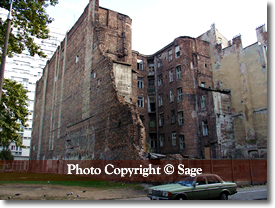|
|
|
| Inside the museum, I felt horrified to see this picture panel - most part of the city was destroyed and was turned into a desert of ruins. |
|
| The then Polish Army uniforms and a woman paramedic with a first-aid kit. |
|
| And the portrait of Władysław Szpilman was on display. He had miraculously survived the Warsaw ghetto, as described in Academy Award-winning movie, "The Pianist." |
|
| |
|
|
|
|
|
| I came across this boy again. I instantly recognized him whom I had met in Stare Miasto, the Old Town. I never thought I would meet him again here at this museum. I felt so painful when I saw this small Boy Insurgent armed with a gun to fight againt the Nazis. |
|
| The documentary film was being showed. |
|
| I found a familiar statue; it was definitely the same mermaid statue I had seen on the bank of the River Vistula. But its size was much smaller.
I later learned that this mermaid was modelled on a famous Polish poetess and was also killed in the uprising. |
|
| |
|
|
I guess I spent two hours at this museum. Outside near the gate of the museum, I noticed a poster column that was covered with a number of pictures drawn by school children in Poland. They were Polish army, nurse, and the burning city… I cried out loud in my heart
Never, ever again! |
| |
|
|









